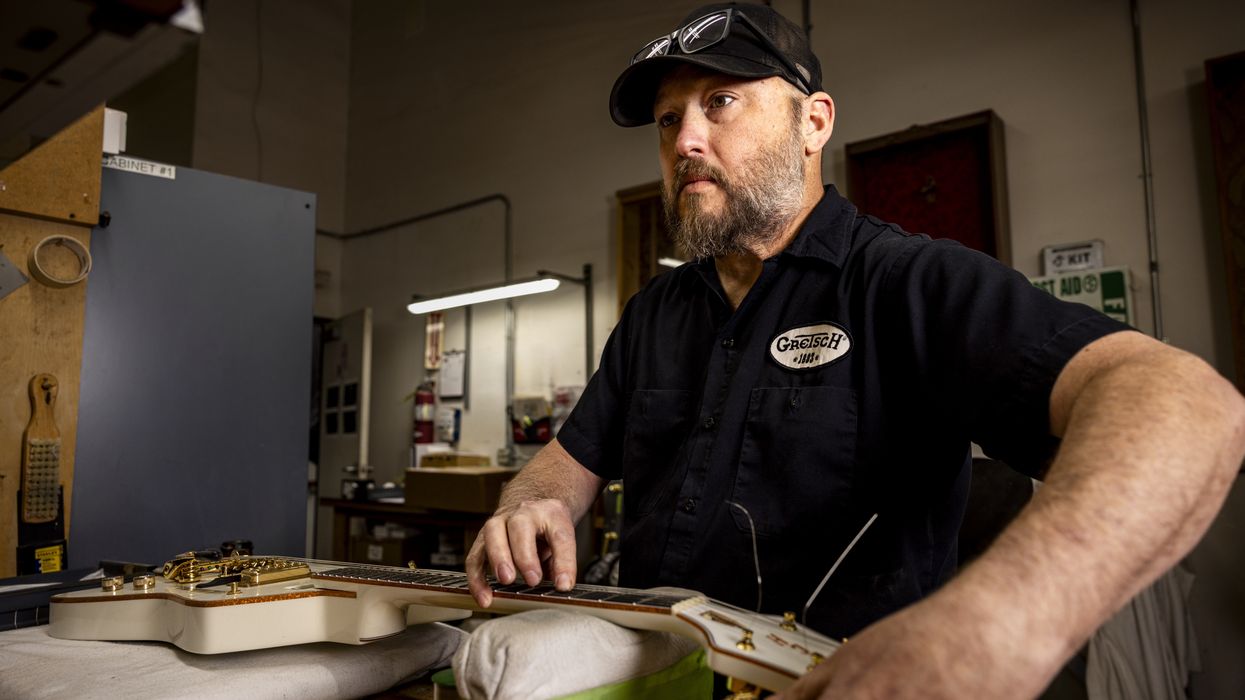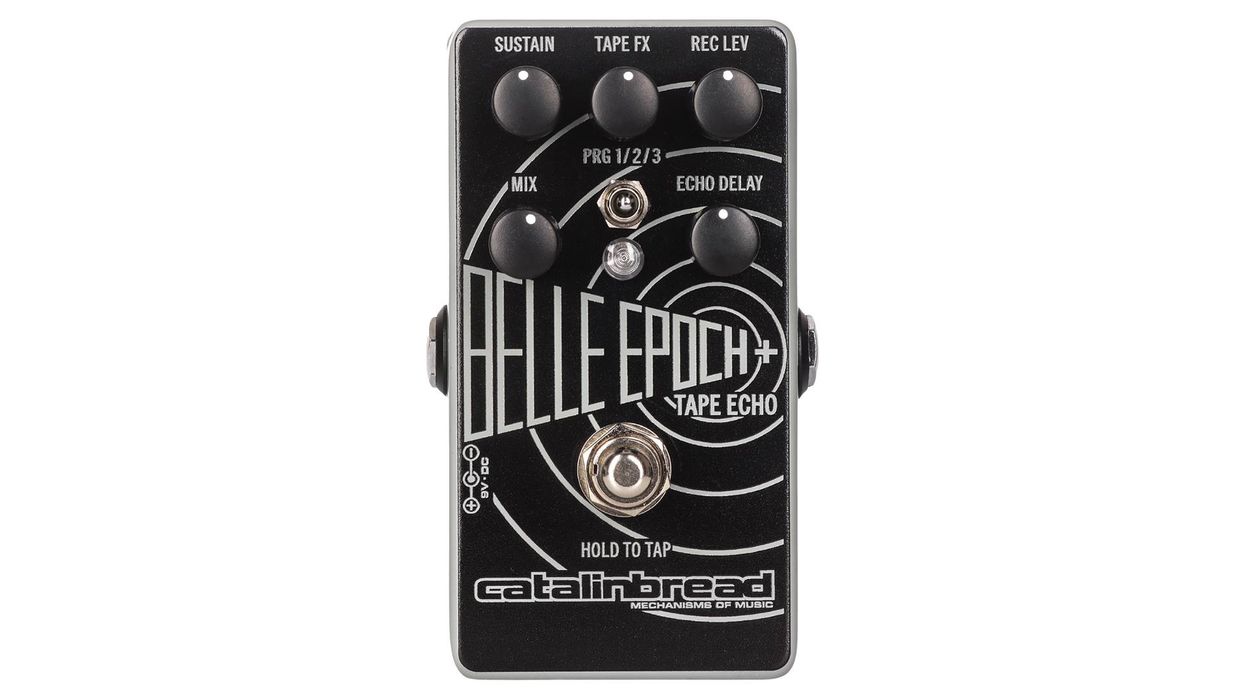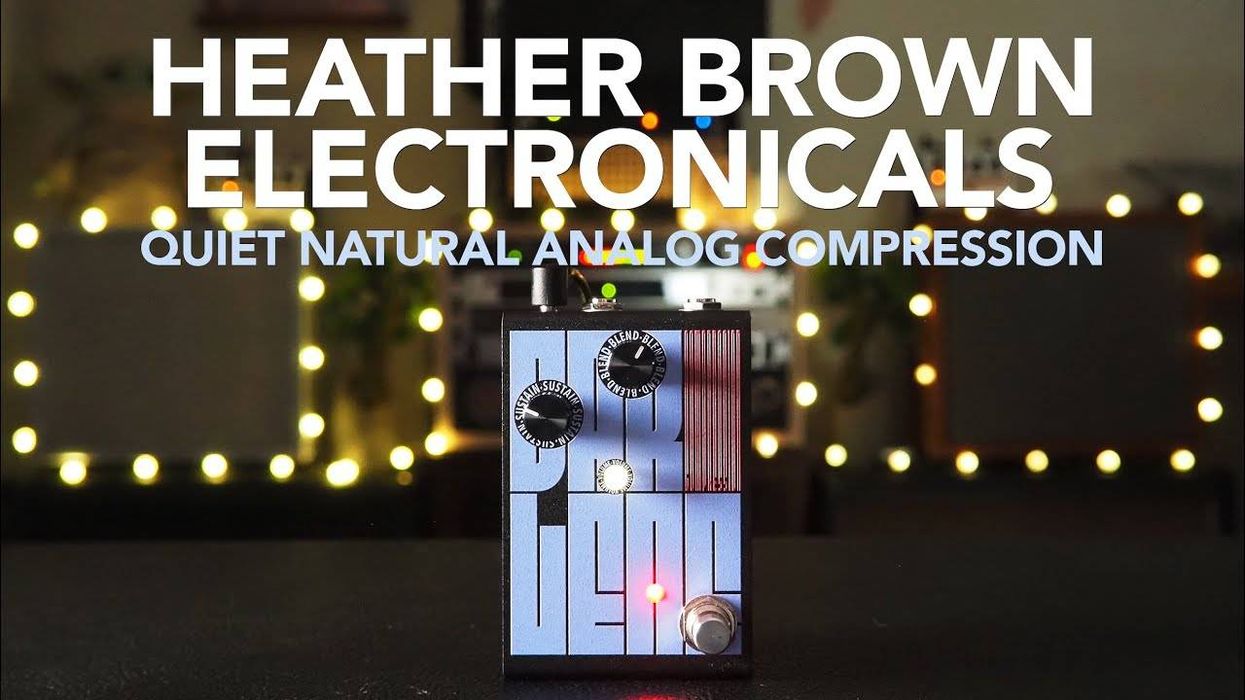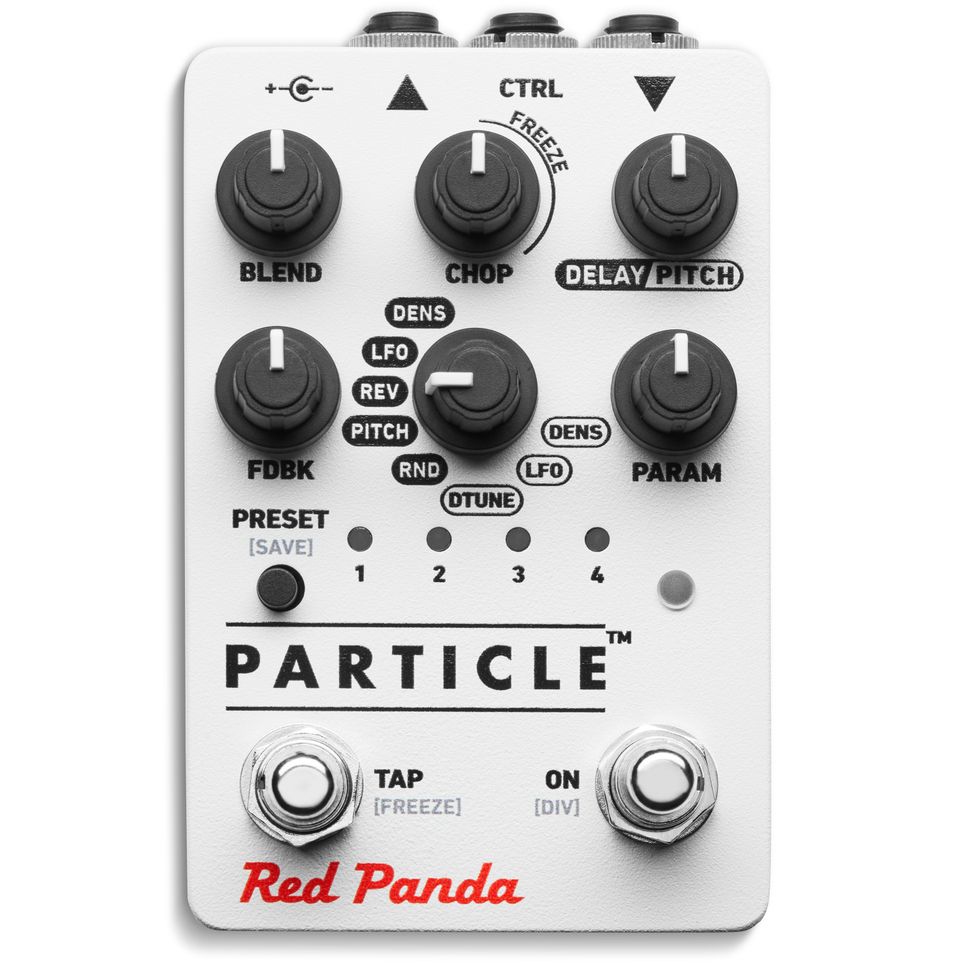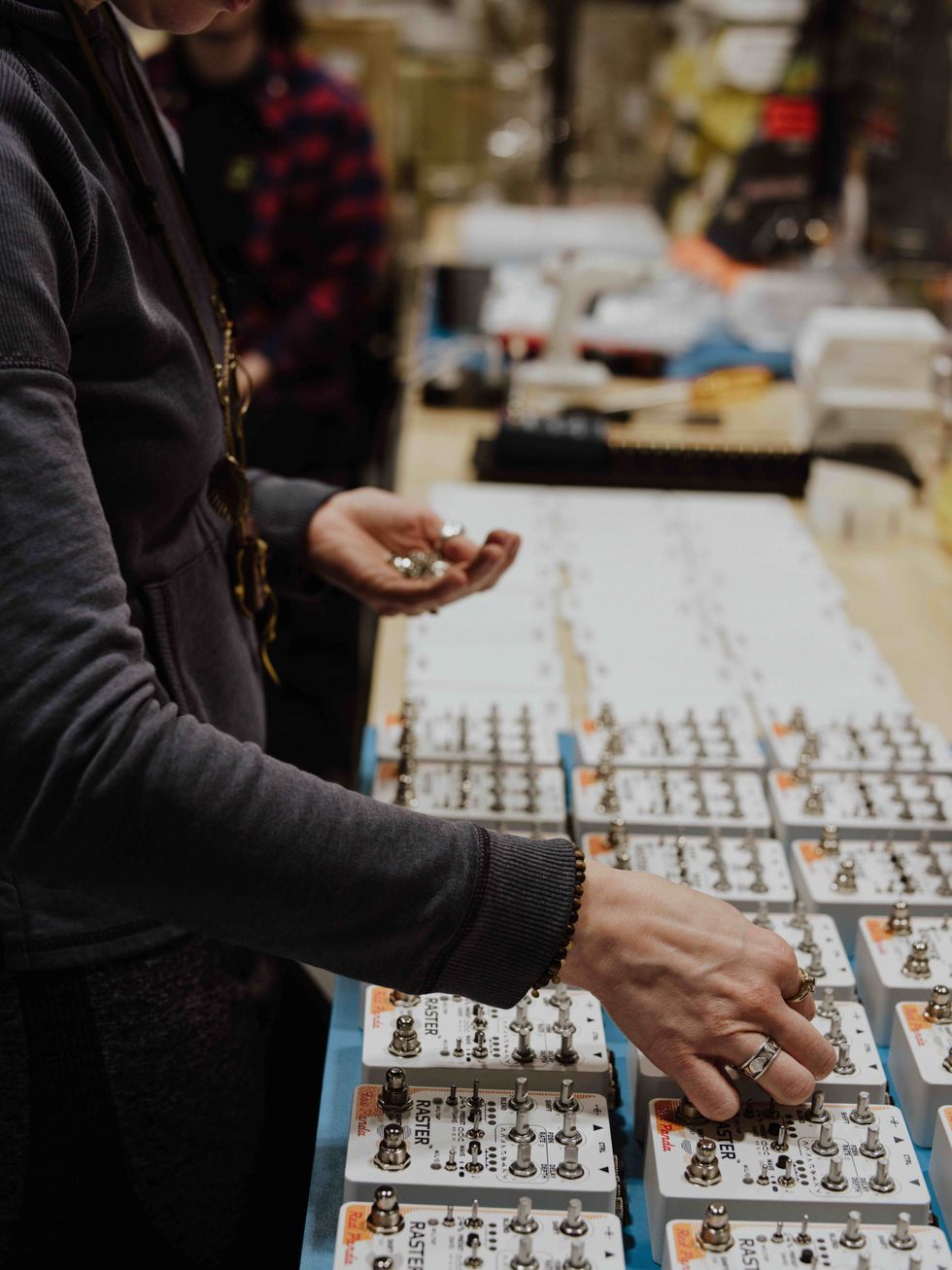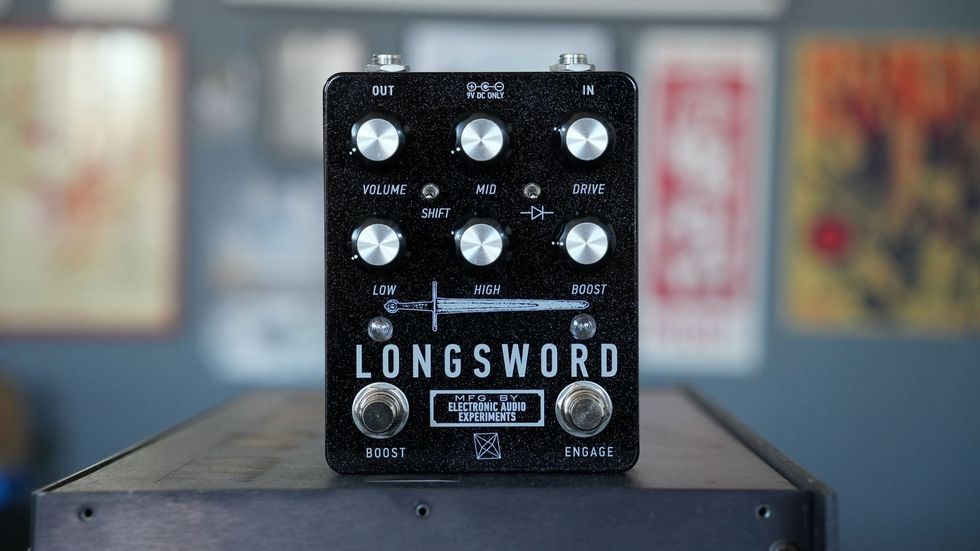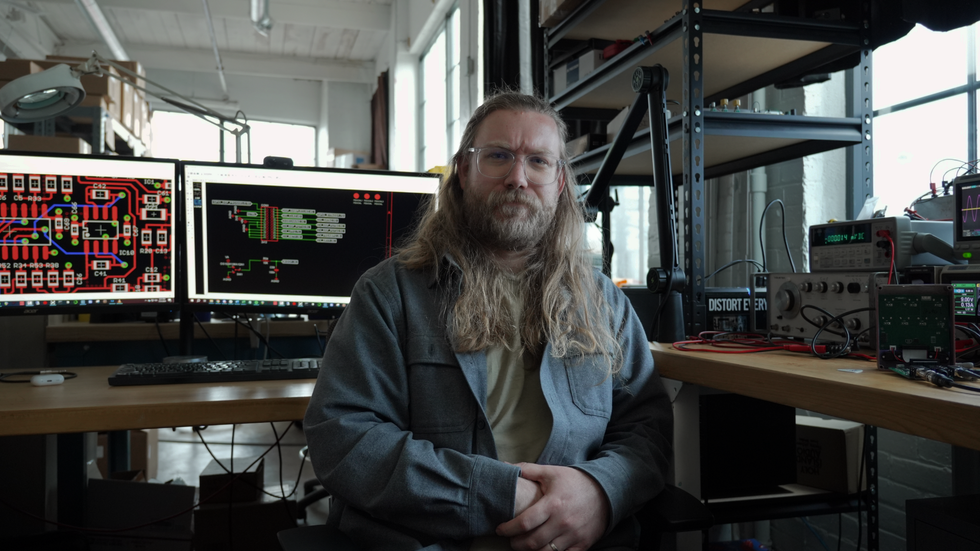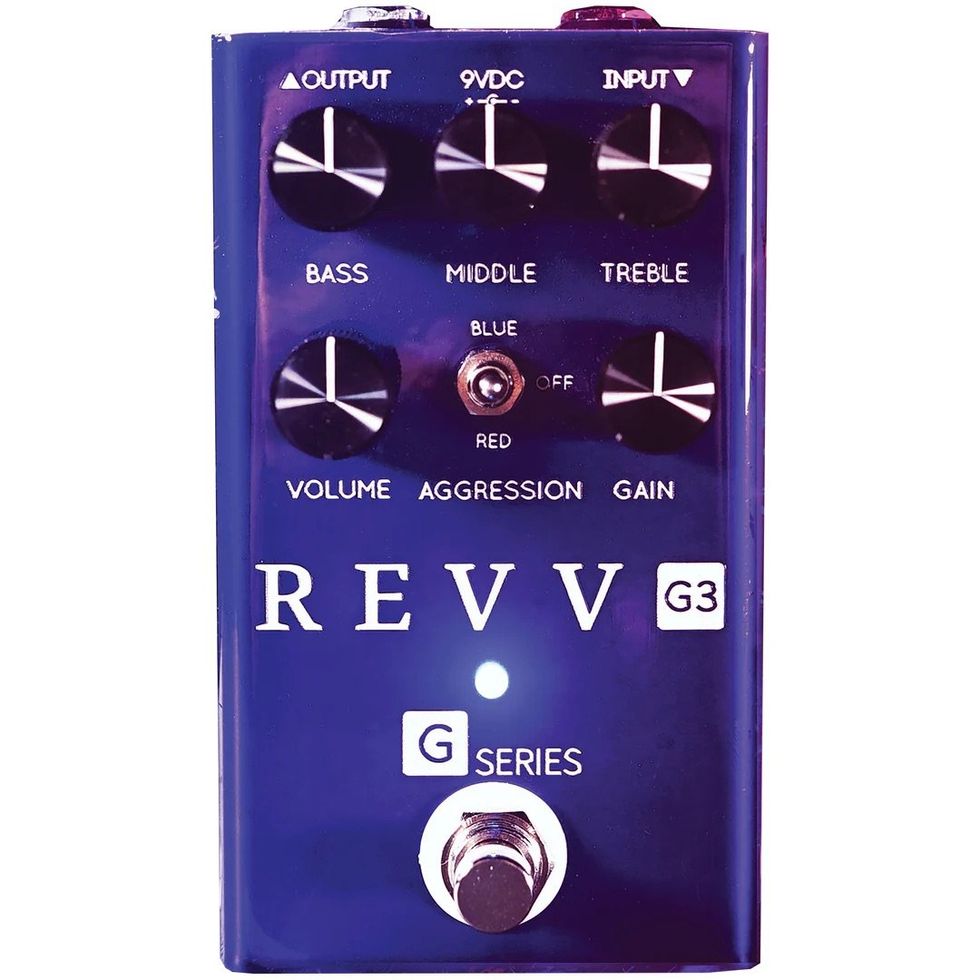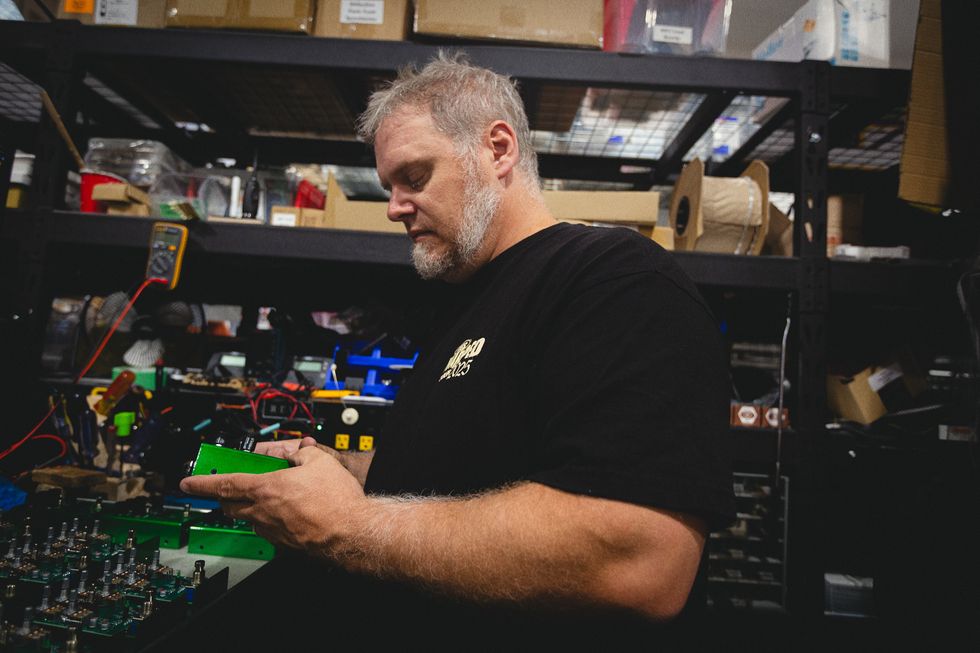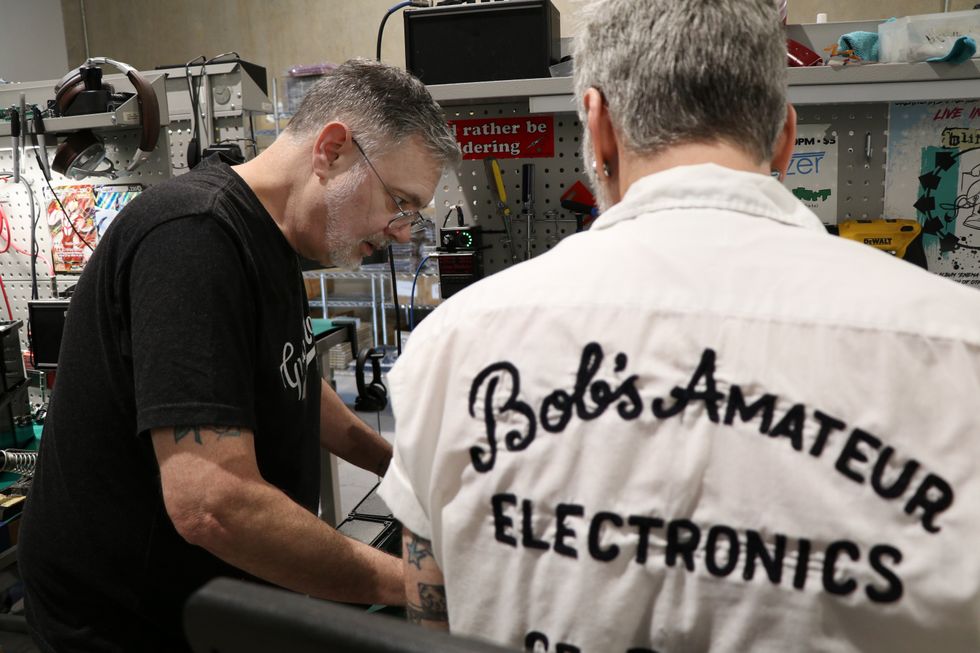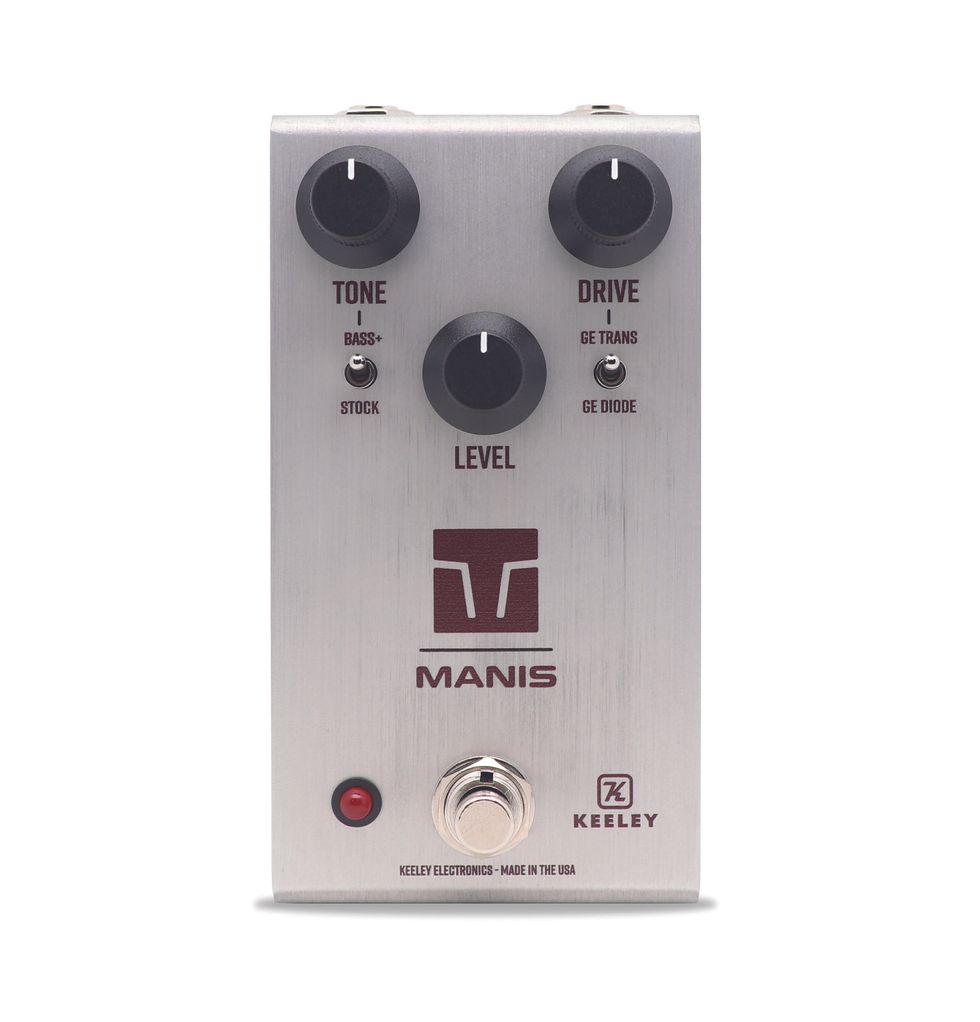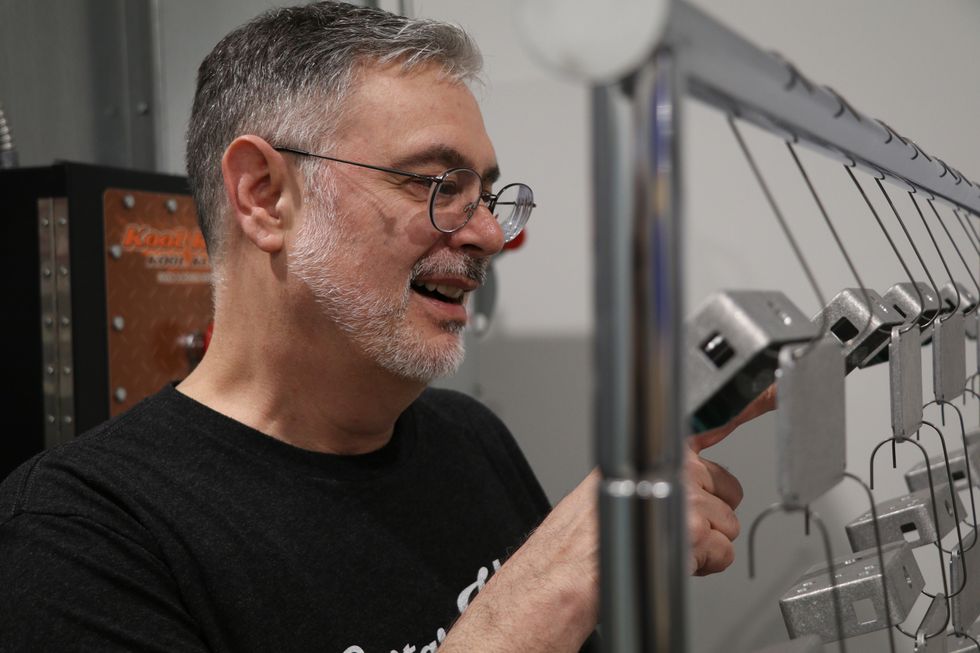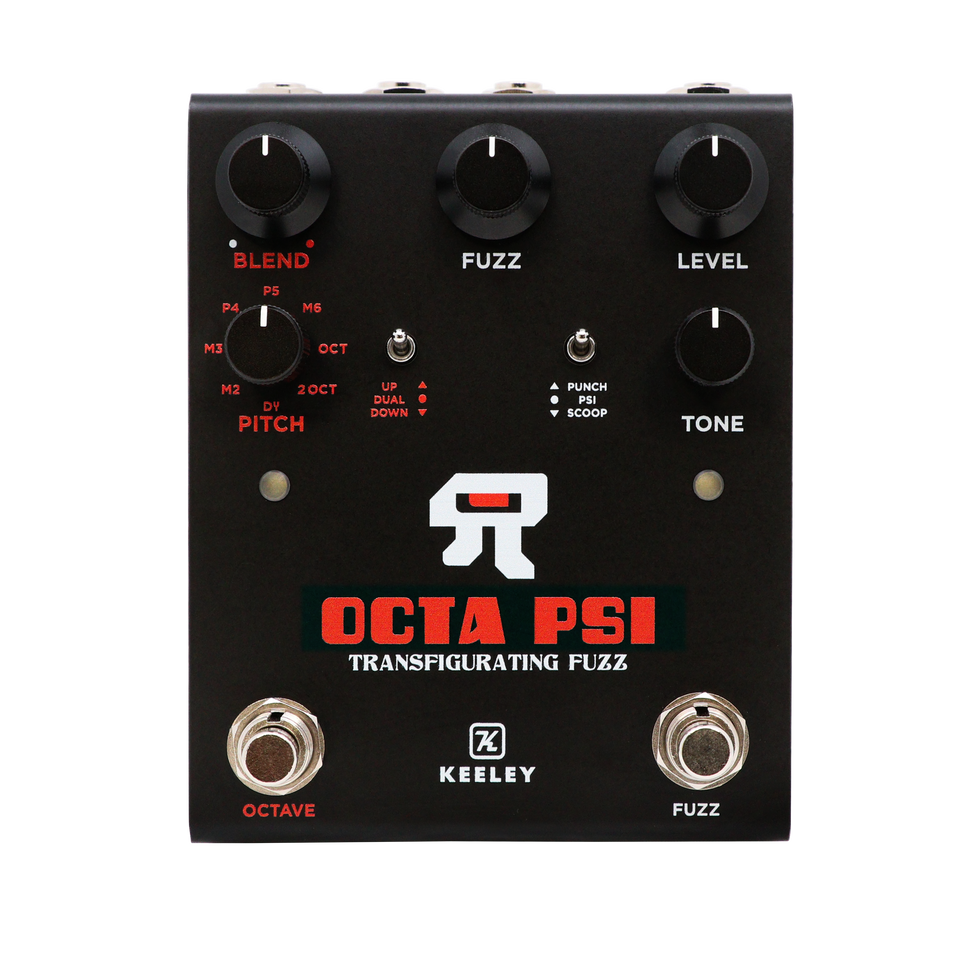The art of guitar building lies somewhere between Zen and a lightning strike. The watercourse way of experience dictates some processes, their workflow eased by years or decades of practice. Other turns come in a flash of inspiration and leave an instrument that will give off a distinctive creative charge for decades.
Chad Henrichsen’s inspired builds for the Gretsch Custom Shop are exemplary. Online, you can see his matching Bastogne walnut Duo Jet and Penguin models, as resplendent as Louis XIV furniture, but with a whole lotta music inside. A little searching also reveals a Baritone Jet in an explosive nitro silver sparkle metal flake finish, showing how high a low-tuned instrument can fly. There’s a ’59 Penguin Relic in sonic blue that boasts a vintage voice to match, via TV Jones TV Classic pickups, and a paisley-and-goldburst ’55 Relic Duo Jet with a hiply retro cat’s-eye f-hole, Seymour Duncan DynaSonic pickups, and a Bigsby B3C tailpiece. The guitar looks as if plucked from George Harrison’s dreams.
YouTube It
That’s just a handful of the multitude of guitars Henrichsen’s made with equal measures of precision, inspiration, and love since 2008, when he joined the Corona, California-based Custom Shop, where he and Gonzalo Madrigal are the master builders. “My mind is constantly running at about a million miles an hour,” he says. “I am always thinking of a different way to do things, like how can I change the internal body chambering structure to maybe make a guitar sound a little bit different? Sometimes those thoughts are fleeting, but when I get one that really sticks I might write out a spec sheet just to have it saved, and go back to it later and build off of that original idea and play with it.”
Those ideas sometimes become the spark for the instruments that Henrichsen makes for the Custom Shop’s annual online dealer events, which he describes as “sort of a mini NAMM show for us. We come up with our own builds and really play around with our ideas.” Some of the results get ordered for top dollar; others are not so lucky. But either way, Henrichsen feels he walks away a winner. “What sticks and what doesn’t gives me a chance to see if I’m in line with the customer base. Some get great reviews; some kind of fall flat, and so you go, ‘well, let me focus on something else.’”
“There were so many little things I had to take in bite-sized chunks as I went along. When I was faced with something I hadn’t seen before, I had to figure it out.”
Henrichsen describes his ascent to master builder as “kind of a weird journey. I actually went to school to be an audio engineer. I wanted to work in a studio and play with faders and all that stuff, but the timing was less than desirable, meaning I got into it at the time DAWs started coming out, and recording technology became widely available to home consumers. That shift happened as I got out of school, so I took a detour. My bandmate at the time got a job here at Fender [which owns Gretsch] and helped me get hired as a setup tech, and then I quickly progressed into doing repairs.”
He’d already been rehearsing for that gig. “I was really interested in guitars and I’d been tinkering around with them,” he says, “swapping pickups—real simple things—and then started working here and really dove headfirst into it. I talked to a lot of the builders that had been here a long time. I got a lot of good pointers, and luckily I had a little place at home where I could go and make some sawdust. I was no stranger to saws. Maybe not so much routers, but I knew how to handle them, and I looked at it from a thousand-foot view and realized, ‘this is just geometry.’ You can make things very complicated if you like, and especially in the Gretsch world, where our designs often dabble in the complicated side of things. But if you want to build a Strat or a Tele, it’s not that much work. So, I started building my own guitars at night and on weekends, and it just snowballed from there. I kept upping my game and kept trying different things, like ‘Now I want to do a carve top,’ and ’Now I want to do a set neck’—and just kept developing my skills.”
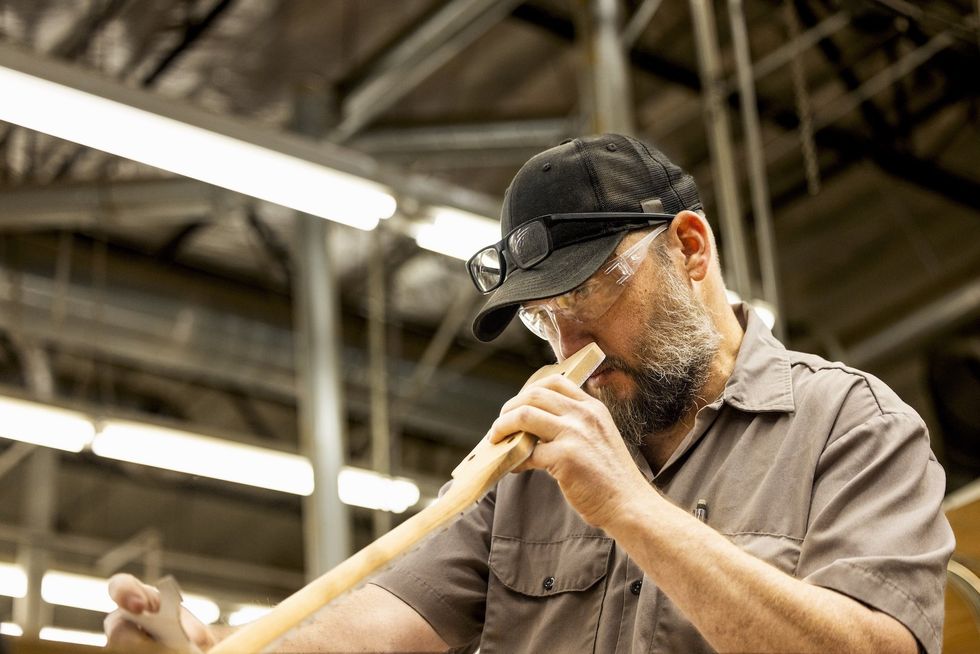
Although Henrichsen can build any Gretsch guitar from scratch, his specialty is necks—the most important aspect of an instrument’s playability. “As far as making necks and bodies, we keep it very old school,“ he says.
Henrichsen’s first home-builds were “really models that I wanted for myself and just didn’t have the money to buy. My very first was like a SoCal-style Strat, with a humbucker. The second was basically a copy of a ’54 Les Paul with P-90s and a wraparound tailpiece. That’s where I dove into carve tops. I made a carve-top Telecaster with some Filter’Trons in it. In building my own instruments, I could make them to an exact thickness, make the neck shape exactly how I wanted it. It’s fun to watch it take shape throughout the process, and it gives you a sense of accomplishment after a few months of toiling at home after work when you see it come together and finally get to plug it in and make some noise. It’s the greatest feeling ever, really.”
“We take a problem and we find a solution with what we have to work with: chisels, drill presses, handheld routers.”
After about 18 months at Fender’s Corona factory, Henrichsen transferred to the distribution center. “I worked in the inspection and repair department that deals with all the import models that come in,” he recounts. “We do checks on all that stuff, and if things need to be fixed, we do that. I ended up supervising that line for a couple years, and I applied for the Gretsch position a year before I got it.”
Asked if he hit any serious roadblocks while developing his building technique, Henrichsen replies, “There were so many little things I had to take in bite-sized chunks as I went along. When I was faced with something I hadn't seen before, I had to figure it out—whether sketching it out on paper or making real rudimentary drawings in CAD, like ‘Okay, here’s my bridge height, here’s the thickness of my body, the rise of the top.’ A lot of people do this very differently. Some do actual full-size, one-to-one-scale sketches. It was a lot of little things and I slowly chipped away at them.
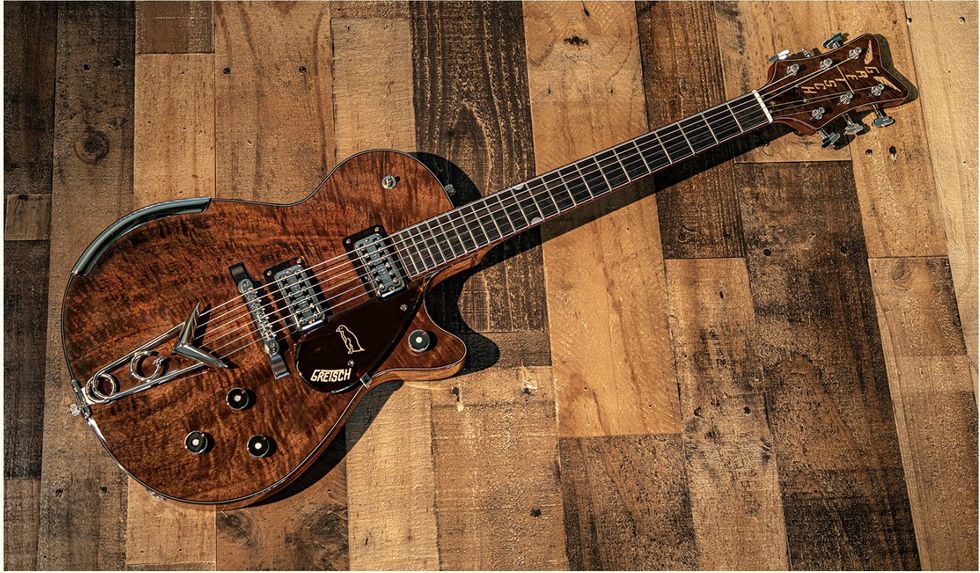
This gorgeous walnut G6134 Penguin is one of Henrichsen’s recent creations. It has a natural stain finish, tortoiseshell/cream binding, chrome hardware, a mahogany neck, an ebony fretboard, and a mother of pearl inlay at the 12th fret. The TV Jones TV Classic pickups enjoy a treble-bleed circuit and a no-load tone control.
“In the Gretsch shop, we hardly use any CNC. We do use CNC for the logos and the inlays, just for speed and consistency, but as far as making necks and bodies, we keep it very old school. We actually have an old copy carver, a purely analog machine, and if we want to do a solid top, we actually use that old copy carver. We actually take a lot of pride in not having fancy new machinery. We don’t have engineers that need to program things to make something happen. With Gonzalo and myself, we take a problem and we find a solution with what we have to work with: chisels, drill presses, handheld routers. We obviously have a pin router for things, but other than that, it’s a lot of hands-on work, and I love that.”
So do customers who order a guitar from the Gretsch Custom Shop, which has eight staffers in total. “We have a very small shop and it’s just filled with woodworking tools: joiners, planers, pin routers, edge sanders. It is not fancy by any means,” Henrichsen says. “It’s like a very small cabinet shop. Gonzalo and I have help with finishing and binding, but we basically oversee the whole process. Gonzalo focuses mainly on bodies. I focus mainly on necks, but if either of us has a build that we want to do…. I’ll dive in and make bodies and he’ll make the necks, so our jobs are very intertwined. But just for the sake of efficiency, we tend to stick to those two areas so we can move as fast as we can yet still retain that handmade vibe the Gretsch Custom Shop is known for.”
“Gretsch is kind of known for gadgetry throughout the years, and so to have all those switches.… To me, it’s kind of like piloting the space shuttle, but we’ll happily build whatever they want. I like the surprise orders. And tone is very subjective.”
Exactly how long it takes to deliver a guitar once an order comes from a dealer or player depends on the complexity of the build, as well as how many orders are in line before it. “Something like a standard ’57, ’59 Duo Jet—we can get those out pretty quickly. But a custom Falcon with three pickups and custom inlays and things like that—that all adds to the time,” the luthier says.
One of Henrichsen’s favorite instruments to build is the Tom Petersson Signature 12-String Falcon Bass, which is tagged at $12,999. “It is such a monster, and the reason I like it is because I have to do things very differently from all of our standard necks. For a Jet or a Penguin or Falcon, I have jigs that I use on a shaper table, a pin router.... That speeds things up a little bit for me. But that 12-string bass neck? I literally have to do most of that on a standard router table by hand. That makes you think a little bit differently, keeps you on your toes, and there’s really no room for error. It’s a measure twice, cut once sort of situation.”
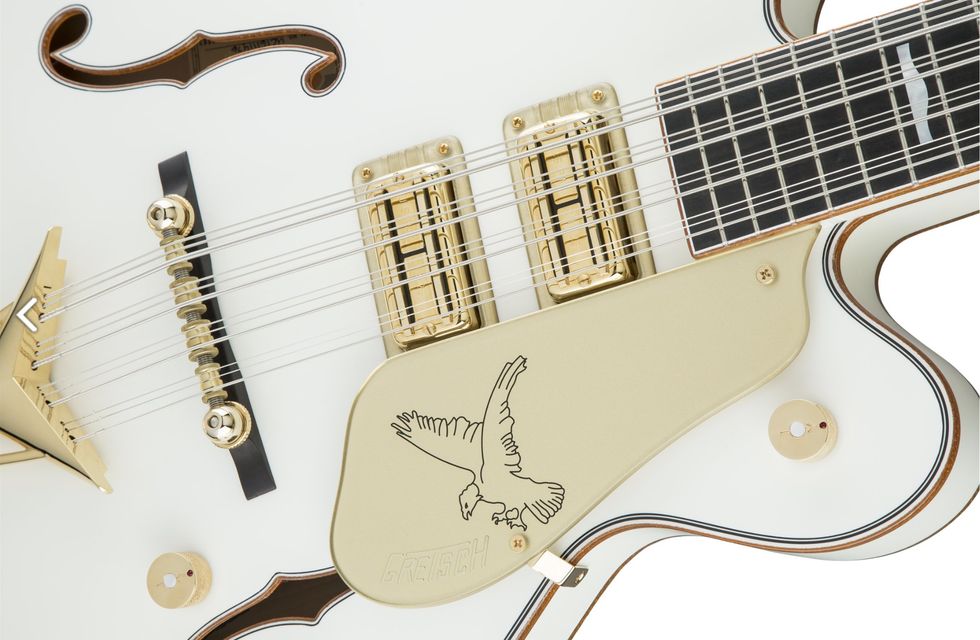
Here’s a close-up of the Tom Petersson Signature 12-String Falcon bass, focused on its pair of Custom Seymour Duncan Super’Tron pickups. But for Henrichson, the 3-way switch electronics are a snap. His favorite challenge is hand-shaping, without templates, the 12"-radius neck, which has a 30.5" scale length.
Electronics are another matter. “I love playing with different types of pickups,” he says. “If somebody wants that classic Gretsch twang, then I would go with a TV Classic or maybe a Ray Butts Ful-Fidelity, or if somebody wants a little bit more output, then maybe a Power’Tron. We do a lot of 3-pickup guitars, where you might have a Super’Tron in the bridge, and maybe a DynaSonic or a TV Jones T90 in the middle position. I love mixing pickups because it expands your tonal palette. We could get into the arguments about tone pots or tone switches. I’m not a big fan of the tone switch, but there is a place for them, and some people love ’em, and it doesn’t matter to me when a customer order comes down. You get what you want. But most of the guitars that I come up with are going to have a tone pot. I do enjoy the no-load tone pots, so most of the time that tone’s running wide open. I’m a big believer in trying to keep that signal path as short and as clean as possible. I had a Falcon order a few months ago where the customer wanted a blower switch for the bridge pickup. He also wanted a phase switch for the pickups, and coil taps for each pickup. It took me a couple days to map that out, but it was great fun! And Gretsch is kind of known for gadgetry throughout the years, and so to have all those switches.… To me, it’s kind of like piloting the space shuttle, but we’ll happily build whatever they want. I like the surprise orders. And tone is very subjective.”
“You don’t want to think about your instrument at all. You just want to be that instrument.”
Given that, what does Henrichsen do when a buyer asks for a “crunchy” sound, or something bright and biting? “I reach out to the customer and have a conversation, to say, ‘Okay, what is your idea of brightness or grittiness,’ or whatever adjective they’re using, and try to narrow down as much as I can, so then I can offer suggestions about pickups. But that’s a tough one, so I try to talk it out and offer different options. We explain that, in our experience, if you use this pickup with this body style, this is the kind of sound that you’re going to get. Obviously if you want a really tight focused sound, a full-size hollowbody may not be your thing. All those little things factor in.
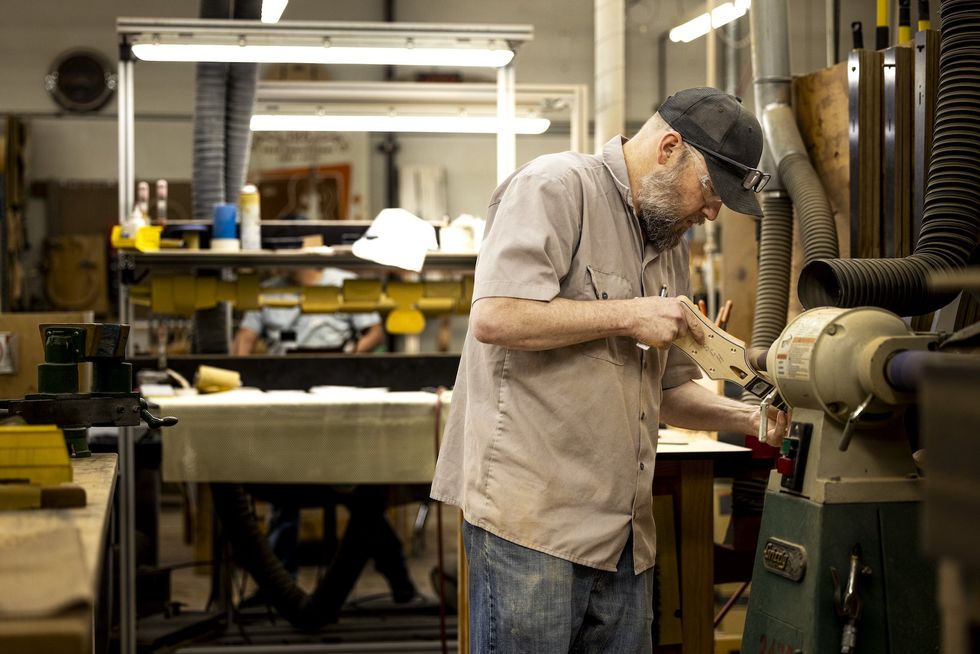
Henrichsen sands a neck in the Custom Shop, which he says looks very much like a small woodshop from decades past.
“If I want that really open, big-sky sound, I’m going to go with a Falcon. But if I want something a little tighter, I’m probably going to go with a Jet and maybe even a center-block jet, to tighten it up even more. I’ve done some builds in the past where our Jets and Penguins, even though we call them solidbodies, have not been very solid. They’re highly chambered inside, and I’ve played with the floor of that chamber—lessening the depth—to see how that changes the sound. That’s part of the fun I have as a builder—playing with those dimensions and seeing the results.”
The endgame of all this, of course, is to create a great-playing and -sounding guitar. The key, says Henrichsen, is “attention to detail. That is one of the things I’m most proud of about the shop. All of us really are paying attention 100 percent of the time. Of course, we make mistakes; we’re human. When you are doing some of the run-of-the-mill operations, it’s easy to let your mind wander and you think about, ‘Oh, I’ve got to feed the dogs when I get home,’ or whatever. But we really try to be cognizant of that and get that tunnel vision, in a good way. With woodworking, if you’re not paying attention for half a second, things can go sideways, or you may miss a little hairline crack in that wood and it may rear its ugly head later on when you’re trying to put a finish on it. If every little piece that makes a final product is the best it can be, then that final product is going to be even greater.
“The player can immediately recognize when the proper attention has been paid to details,” he continues. “We do a lot of binding over frets, for example, and when you have those fret ends nice and smooth, it feels comfortable. Things are balanced. The last thing you want as a player is distractions. You don’t want to think about your instrument at all. You just want to be that instrument. It needs to be a part of you, not something that you’re fighting. When the customer picks it up, and it just works and it feels great, and they have no complaints whatsoever…. That’s our end goal every time.”
